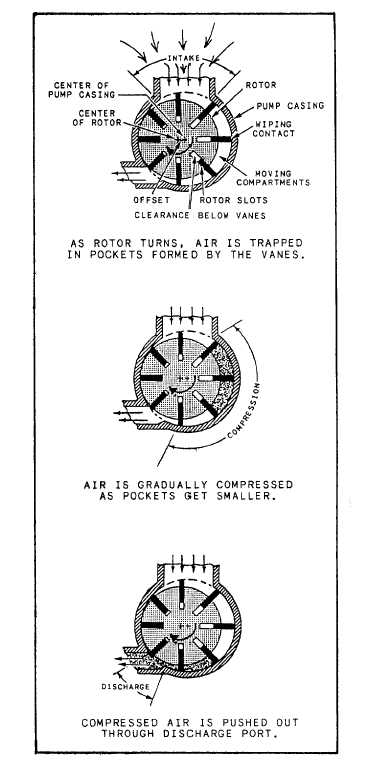compressors may be air or liquid-cooled. The compressors used by the NCF are almost identical to those used in private industry. The difference is not in the compressor, but in the trailer that carries the unit. For example, a Sullair 750 cfm 250 psi unit is carried on a specially modified trailer. This is done to allow the unit to be mobile loaded on a C-130 type of aircraft for air detachment exercises and other contingency purposes.
RECIPROCATING COMPRESSOR
The cylinder block of the reciprocating compressor is designed much like that of an internal combustion engine found in most automobiles. The similarity ends at the cylinder head that is constructed specifically for air compression purposes. Figure 8-2 shows the basic movement of air through the reciprocating unit. As the piston moves down, air is drawn into the cylinder through a one-way intake valve. Once the piston reverses direction and begins upward motion, the intake valve is forced closed, and the compression of air forces the discharge valve open, passing the air out of the cylinder and into the air receiver. The most common intake and discharge valves are simple spring-loaded devices, varying in design and size according to the size of the air compressor. The reciprocating compressor is most likely to be found at public works stations, in a shop supplying air for industrial use, or under the hood of CESE with air actuated brakes
SLIDING VANE (ROTARY) COMPRESSOR
Currently, the most common industrial air compressor in the NCF is the oil-injected rotary vane type. This particular type of air compressor, simple in design, has fewer moving parts than the reciprocating unit, making maintenance less of a problem. It gives a more constant flow of compressed air, is compact, and is almost vibration-free. The common sizes range from 125 to 750 cfm. Figure 8-3 shows an oblique view of the rotor with the vanes in place, and figure 8-4 shows the basic operation. The rotor turns about the center of its shaft which is offset from the center of the compressor casing. Centrifugal force keeps the vanes extended, maintaining a wiping contact between the compressor casing and the edge of the vanes. This action forces the vanes to slide in and out as the rotor rotates (fig. 8-4). The crescent-shaped space between the compressor casing and the rotor is divided into compartments which increase and decrease in size as the rotor rotates. Thus, when free air enters each compartment as it passes the air intake opening, it is trapped as the compartment rotates closed. The air is then carried around in each

Figure 8-4. - Steps in the compression cycle of a rotary vane compressor.
successive compartment and is discharged at a higher pressure due to the decreasing volume of the moving compartments as they progress from one end to the other of the crescent-shaped space. Oil is injected into and circulated through the air compressor to seal the vanes against the casing walls, to lubricate the internal parts,
Continue Reading